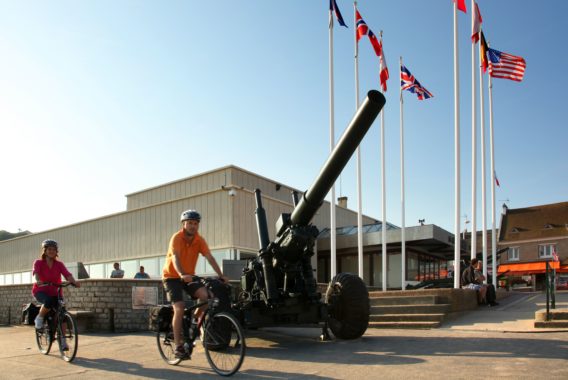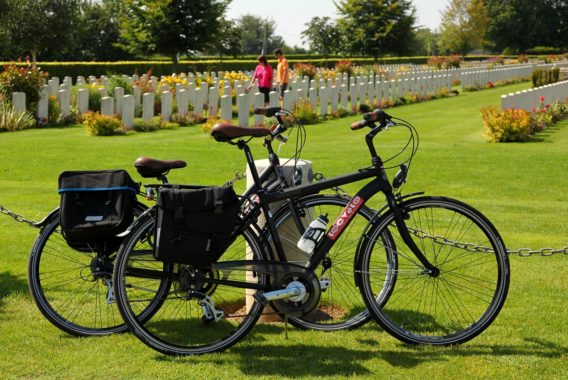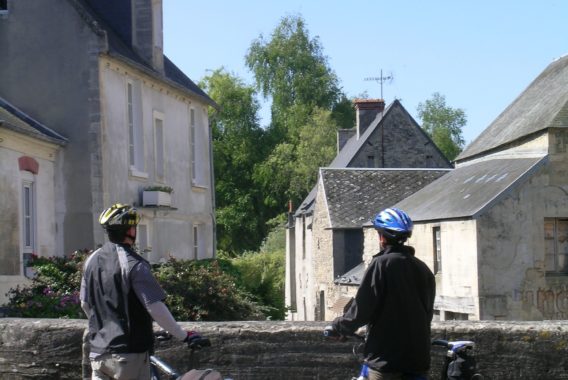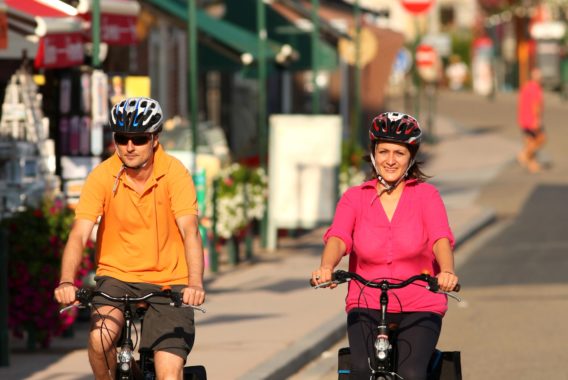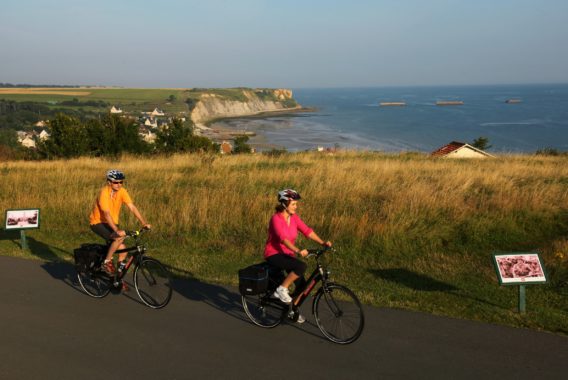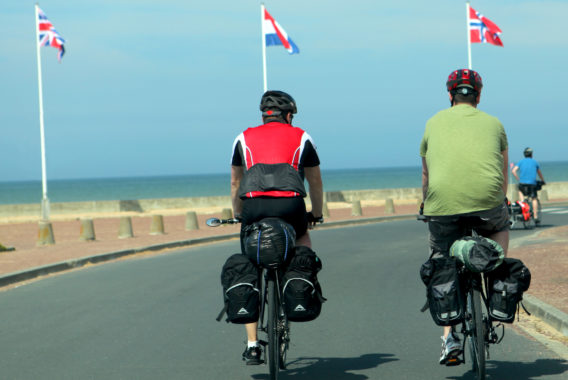Liberation Route Europe by bike
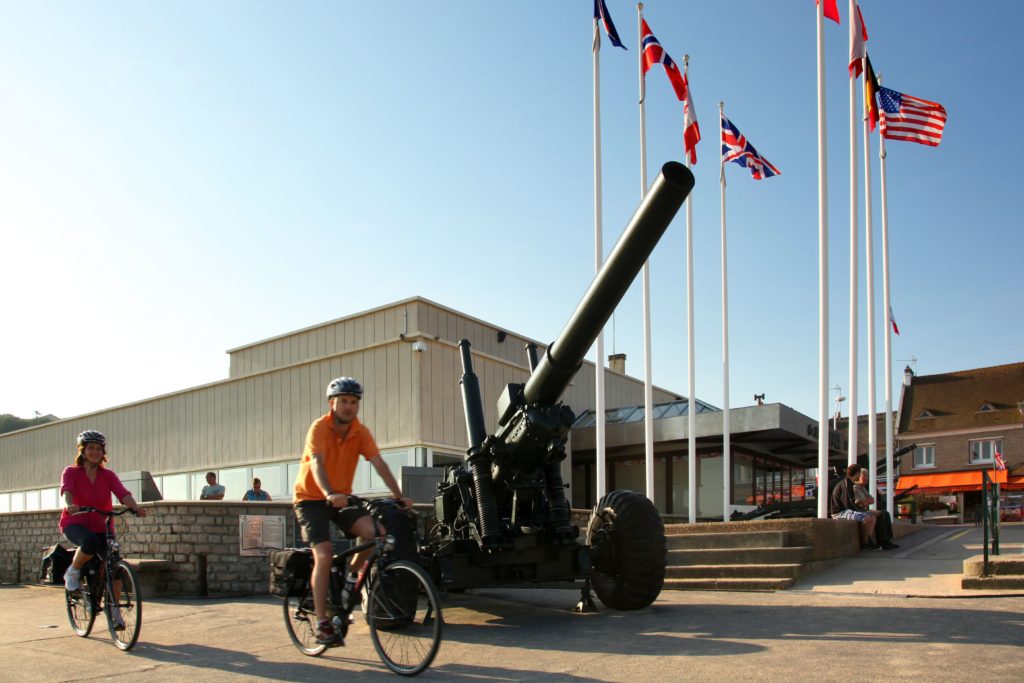
Voir la galerie photo
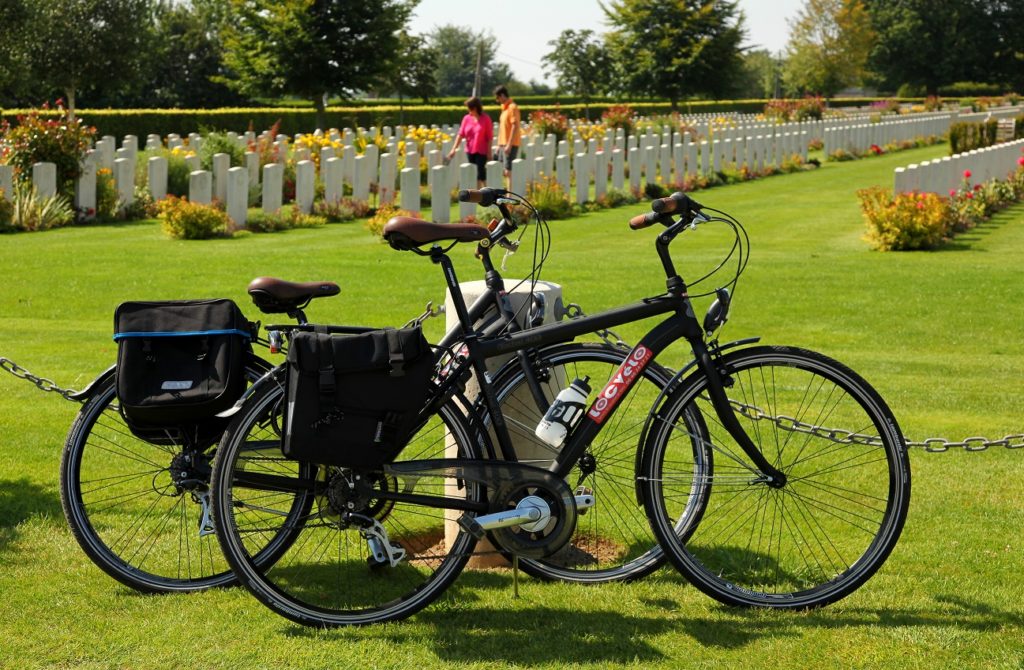
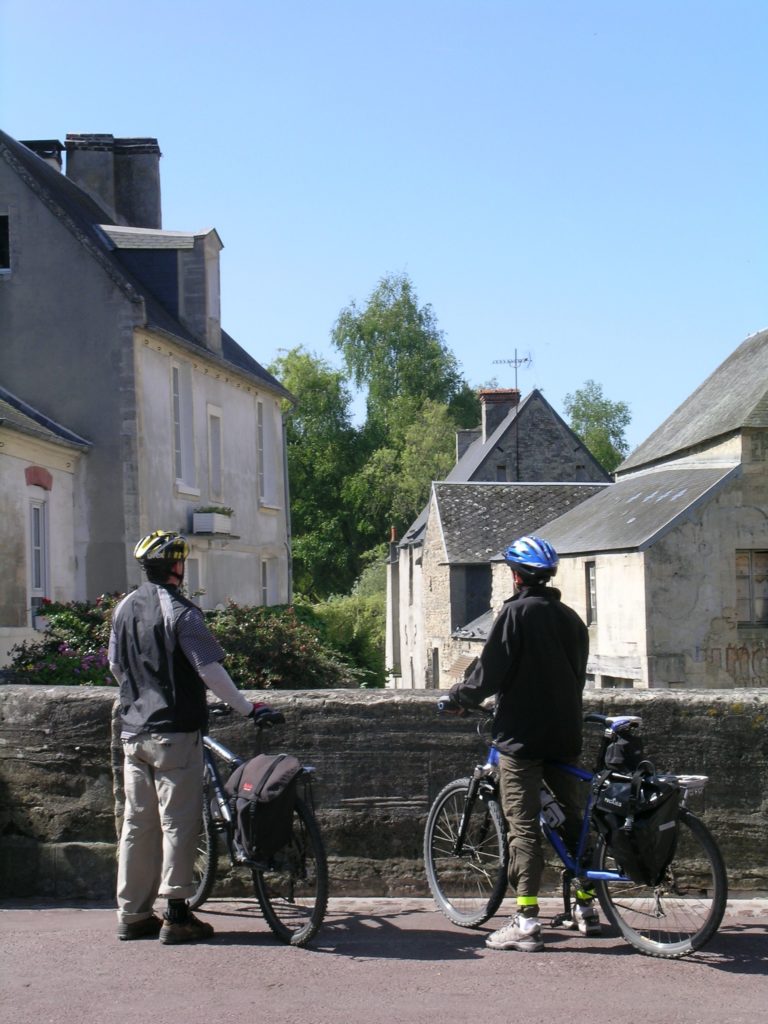
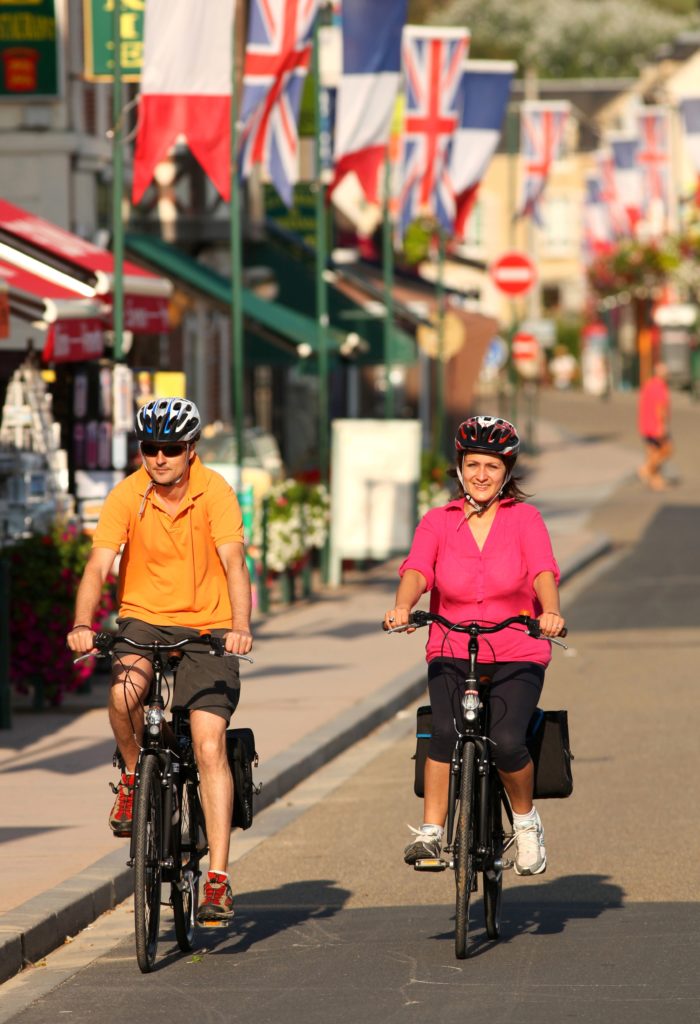
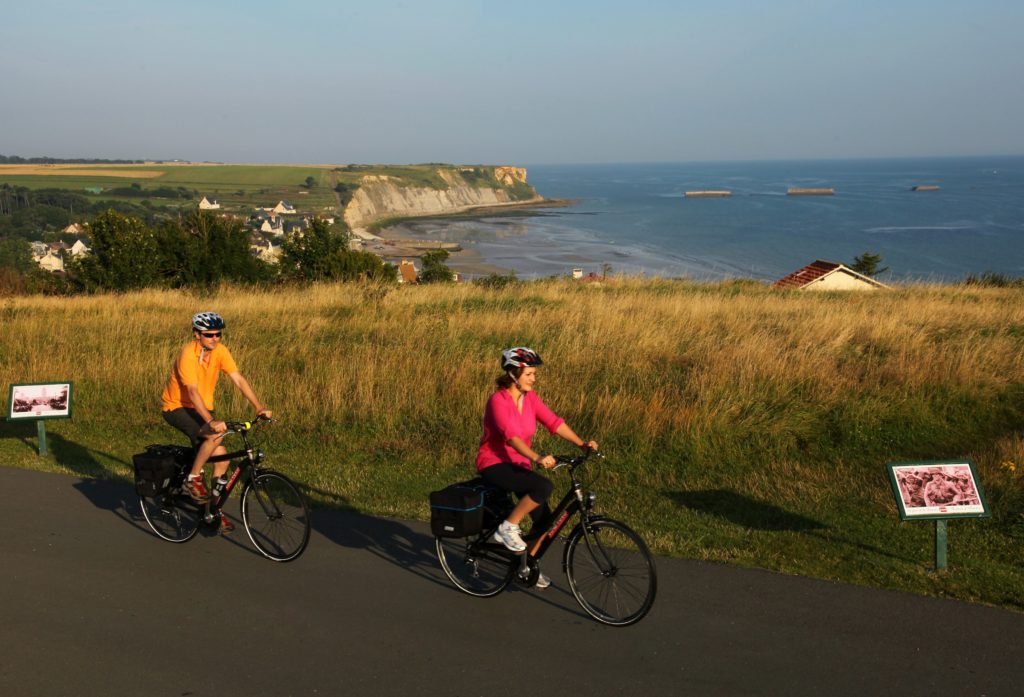
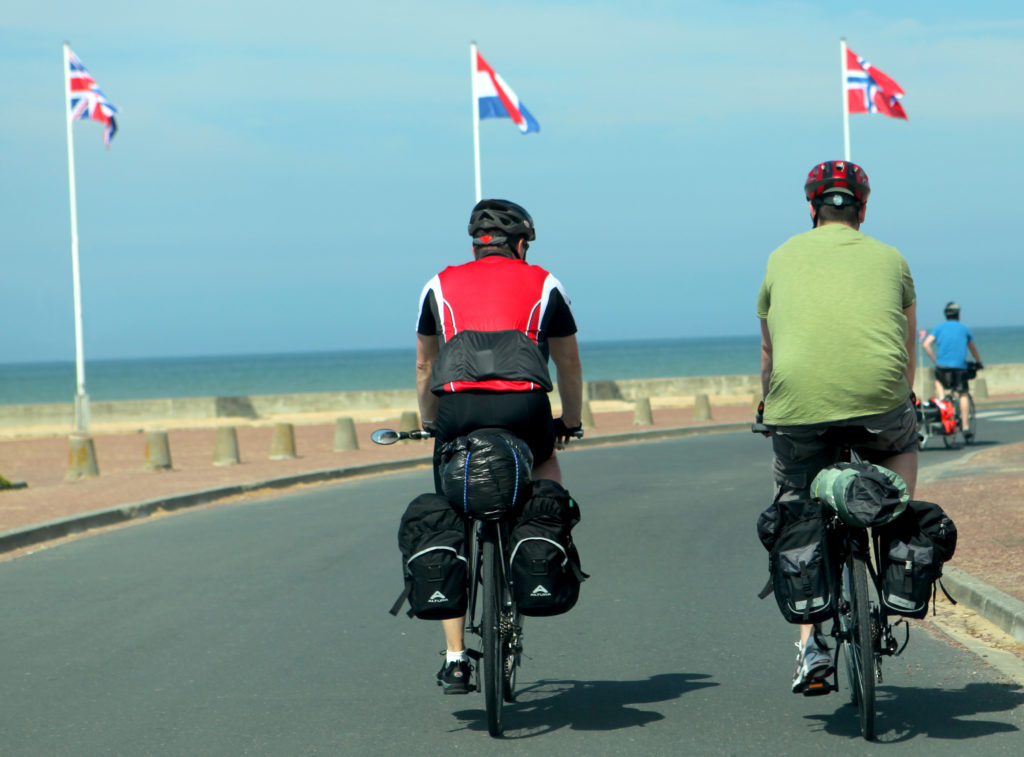
A pilgrimage of more than 250 km, this trip offers you the opportunity to pedal in the footsteps of the Allies during the liberation of Europe in the region of Normandy. From Cherbourg to Caen, many places of memory will be presented to you: the landing beaches, museums, Sainte-Mère-Eglise, Pegasus Bridge, etc. A stay in the heart of European history, to not forget …
Les points forts
- Memory sites of WWII
- Small roads and cycling ways
Le programme
Jour 1 : arrival in Cherbourg
In the summer of 1944, the port of Cherbourg became the first port in the world. Indeed, it represented for the Allies a crucial entry point on the old continent, and it was essential for the supply of the troops located in Western Europe. Despite fierce resistance from German forces, the United States captured the city on June 26, 1944. The Museum of the Liberation of Cherbourg commemorates this important period.
Overnight in a 2* hotel
Jour 2 : from Cherbourg to Saint-Vaast-la-Hougue
Departure on the Vélomaritime (or Eurovelo 4) in the north of Cotentin towards the Val de Saire to Saint-Vaast-la-Hougue. As D-Day approached, the Allies repeatedly engaged landing barges off Saint-Vaast and Tatihou Island to simulate a landing north of Utah Beach. This maritime tactic was carried out until June 8, 1944, forcing the Germans to open fire regularly and allowing the Allied forces to carry out counter-battery fire.
Overnight in a 3* hotel
51 km
Jour 3 : from Saint-Vaast-la-Hougue to Utah Beach
Direction Quinéville along the east coast of Cotentin. The Quinéville site houses an artillery position occupied by the 4th battery of the Heeres Küste Artillerie Abteilung 1261: the Mont Coquerel battery. This battery was bombarded by the USS Tuscaloosa on June 6, 1944. In addition, in 1943, French commandos carried out there for two hours and with success an extremely perilous reconnaissance mission of the beach to obtain various information for the landing at Utah Beach.
Then, you will pass by the Crisbecq battery which played an essential role during the D-Day landings on June 6, 1944, because it resisted the Allied fleet in front of Utah Beach and prevented the advance of American forces. The museum allows visitors to discover how the German army was organized along the “Atlantic Wall”. In Sainte-Mère-Eglise, it is possible to visit the Airborne Museum inaugurated in 1964 at the precise place where the American paratroopers took part in violent fighting during the night of June 5 to 6 and the following days. The museum has a large collection of uniforms, weapons, and other war memorabilia.
In Sainte-Mère-Eglise, it is possible to visit the Airborne Museum inaugurated in 1964 at the precise place where the American paratroopers took part in violent fighting during the night of June 5 to 6 and the following days. The museum has a large collection of uniforms, weapons, and other war memorabilia.
Finally, the first landing beach of your stay. Utah Beach is the westernmost landing beach on D-Day. This is where the US 4th Infantry Division docked. The landing on Utah Beach was rather successful, in part thanks to the airborne troops which prevented any major counterattack on the landing zone.
Included: Entrance to the Utah Beach Museum. Among many war materials and similar, this museum exhibits a rare copy of Martin B 26 “Marauder”, an American bomber of medium size.
Overnight in guest house
49 km
Jour 4 : from Utah Beach to Grandcamp Maisy
During this stage, you will cross the National Natural Reserve of Domaine de Beauguillot, famous for its seals and birds.
In Carentan, it took 6 days of bitter fighting to liberate the city and ensure the junction between the landing beaches: Utah Beach and Omaha Beach.
You will take advantage of this stopover to visit the German military cemetery of La Cambe. With nearly 21,200 graves, it is the largest and most famous German military cemetery in Normandy. Unlike Allied military cemeteries, it is simple and understated in style, which creates a sense of serenity inviting visitors to live in peace.
Overnight in guest house
54 km
Jour 5 : from Grandcamp Maisy to Bayeux
On the way to Omaha Beach! You will make a small detour to Pointe du Hoc which overlooks two of the five D-Day landing beaches: Utah and Omaha. It is famous for the daring assault carried out on June 6, 1944 by the 2nd American Ranger Battalion to neutralize the German artillery battery there.
Then, you will first pass Omaha Beach, the most famous of the five beaches of the D-Day landings of June 6, 1944. On this 6 km long beach, American troops faced German defenses that were still virtually intact. They suffered heavy losses and came close to the catastrophe. Then, you will visit the American cemetery of Colleville-sur-Mer which illustrates and commemorates the sacrifices of the United States for the liberation of Europe, and offers a view of Omaha Beach, which was the deadliest of all Operation Overlord.
Finally, arrival in Bayeux and possibility of visiting a British military cemetery and the memorial museum of the Battle of Normandy. In addition, Bayeux is famous for its Tapestry which traces the conquest of England by William the Conqueror.
Overnight in a 2 * hotel
45 km
Jour 6 : from Bayeux to Courseulles-sur-Mer
On your itinerary for the day, you will pass the German artillery battery of Longues-sur-Mer which enjoyed the ideal location to face the landing of June 6, 1944. Its guns were positioned exactly between the beaches of Omaha Beach and Gold Beach. This battery fought a duel against the Allied fleet before being silenced at sunset on D-Day. You will then arrive at Arromanches-les-Bains where, during the preparation of Operation Overlord, the Allied strategists decided to build two prefabricated artificial bridges in Normandy. They considered them essential to allow the arrival of reinforcements and material on the continent. The remains of the artificial port of Arromanches are still visible today, silent witnesses of this daring bet and this incredible technical feat.
Included: Entrance to the Arromanches 360 museum. Entrance to the Juno Beach Center. The Juno Beach Center is a place of memory representing an entire nation. It commemorates Canada’s participation in World War II and its important contribution to the liberation of Western Europe.
Overnight in a 2* hotel
45 km
Jour 7 : from Courseulles-sur-Mer to Caen
You will first follow the coast and Juno Beach. Assigned to the 3rd Canadian Infantry Division, Juno Beach extended from Graye-sur-Mer to Saint-Aubin-sur-Mer. On D-Day, despite the difficulties in neutralizing some German strongholds and a relatively high rate of loss, Canadian troops managed to push inland before being stranded overnight northwest of Caen.
You will then pass through Sword Beach. Sword was the code name for the easternmost beach of the five D-Day landing beaches in Normandy. The 3rd British Infantry Division landed on this beach thanks to the reinforcement of commandos and the support of specially adapted tanks. The men were to join the 6th Airborne Division and capture Caen. This last objective was finally achieved a month later, on July 9.
Then, you will go to the Museum of the Atlantic Wall in Ouistreham which is located inside the former German headquarters which served as the Fire Direction Post for the batteries covering the entrance to the Orne and the canal connecting Caen to the sea. The 17-meter-high concrete tower has been completely redesigned to give it back the appearance it had on June 6, 1944. The six floors have been recreated down to the smallest detail.
Finally, you will pass Bénouville and the famous Pegasus Bridge. The first objectives captured by airborne troops in the Normandy campaign were two important bridges over the Caen and Orne canal. Shortly after midnight on June 6, 1944, a small detachment of the British 6th Airborne Division surprised the German garrison guarding the bridges. The Pegasus Memorial recalls their daring action and the division’s commitment to Normandy.
Included: Entrances to the Museum of the Wall of Atlantique and to Memorial Pegasus.
Overnight in a 3* hotel
37 km
Jour 8 : Caen Memorial
You will take advantage of the morning to visit the Caen Memorial. Unique in France, it gives the public the keys to understanding the Second World War, from its origins after the First World War, until its last fallout in 1989. It invites the visitor to wonder about this episode that we tend to forget, but that changed the face of Europe and the world.
Included : Entrance to Caen Memorial
Inclus/Non-inclus
Le prix comprend
- Hébergement : 7 nuits en chambre double
- 7 petits-déjeuners
- Le transfert des bagages
- Une assistance téléphonique 7/7
- Le Roadbook numérique (avec GPS inclus)
- Accommodation
- Breakfasts
- Luggage transfers
- Entrances to: Utah Beach Museum, Arromanches 360 Museum, Juno Beach Centre, Museum of the Wall of Atlantique, Memorial Pegasus and Caen Memorial
- Documents
Le prix ne comprend pas
- Le petit déjeuner du jour 1
- Les déjeuners
- Les dîners qui ne sont pas mentionné dans "le prix comprend"
- Half board extra (7 dinners) : 180,00 €/person
- Bike rental (6 days) : 220,00 €/person
- E-bike rental (6 days) : 350,00 €/person
- Lunches
- Drinks
- Insurances
Infos pratiques
Type de voyage
Biking trip on trails and small country roads
Lieu de RDV
Beginning: Day 1 at the hotel in Cherbourg
End: Day 8 at the hotel in Caen
Hébergement et restauration
Nights and breakfasts in 2* & 3* hotels and in guest houses. Dinners in option.
Documents de voyage
1/100000e map and a road book with the detail of the trip
Comment venir
By train :
Go: Paris St Lazare – Cherbourg.
Return: Caen – Paris St Lazare
By car:
Go: Paris – Caen – Cherbourg (about 4h00).
Return: Train Caen – Cherbourg (1h15) then car Cherbourg – Paris.

 Facebook
Facebook Instagram
Instagram